This article was published in Scientific American’s former blog network and reflects the views of the author, not necessarily those of Scientific American
Over virtually 200 years of discovery and excavation, the dinosaur fossil record has given us thousands of skeletons and other such solid, familiar remains. But over the same span of time – no, in fact, over a rather longer span of time – we’ve also discovered a far, far greater number of more ephemeral fossils: tracks, traces, droppings and so on. We call these objects trace fossils, and the science devoted to their study is termed ichnology. Way back in 2014, a new, exciting and comprehensive book appeared on dinosaur trace fossils, and today I’m going to review it… better late than never. The book is Anthony J. Martin’s Dinosaurs Without Bones (Martin 2014).
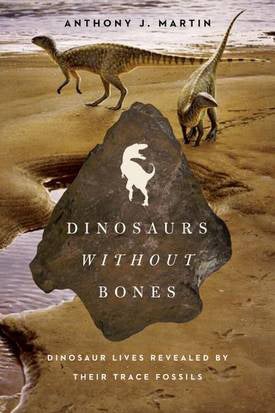
Over the years, I’ve read several books on dinosaur tracks. With all due respect to the scientists and writers concerned, they never have filled me with a tremendous enthusiasm for the subject. The fact that innumerable traces of living, moving Mesozoic dinosaurs are preserved in sediments worldwide is difficult to be nonchalant about (yes, innumerable: there are millions of fossil dinosaur tracks out there) but, for whatever reason, the subject often seems lacklustre.
On supporting science journalism
If you're enjoying this article, consider supporting our award-winning journalism by subscribing. By purchasing a subscription you are helping to ensure the future of impactful stories about the discoveries and ideas shaping our world today.
Dinosaurs Without Bones bucks the trend and not only takes dinosaur ichnology into palaeobiological pastures new, it also introduces and covers a huge number of areas that succeeding in capturing my attention.
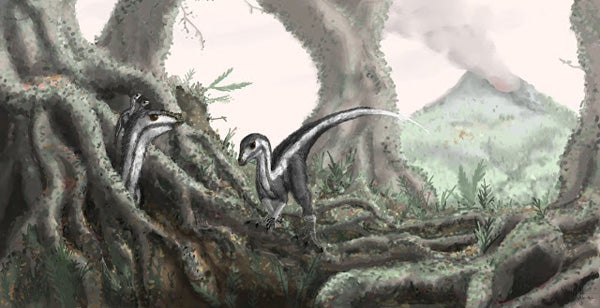
There's more to ichnology that footprints: see below for burrow-dwelling ornithischians. Reconstruction of Oryctodromeus by Mark Witton, from here.
This book will be enjoyed and used by specialists and working scientists, but it isn’t written for them. It’s beautifully friendly and conversational in tone and (even if I hadn’t met him in person) I would emerge from reading it thinking of Anthony Martin as a buddy – he’s engaging and humorous, in places hilarious. His informal, amusing style, the use of numerous anecdotes and the many behind-the-scenes accounts really succeed in making this book a fun read for anyone interested in science: I could seriously imagine it being read by people in airport lounges and so on, and there aren’t many palaeontological books for which that can be said. On the anecdotes, I especially remember those involving cassowaries, and the one about getting left behind and locked in at Lark Quarry.
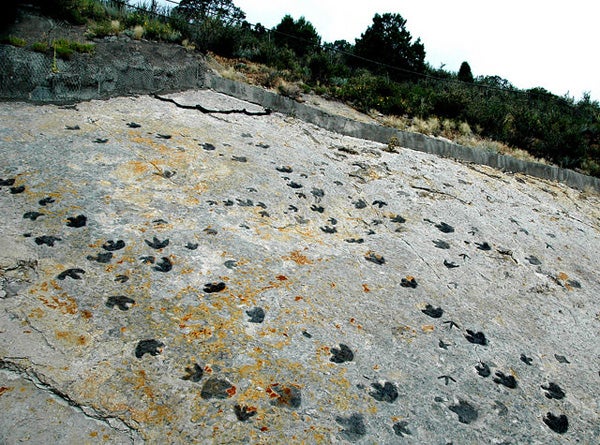
Mesozoic dinosaur tracks are not rare or obscure - millions of them (literally) are preserved at hundreds of locations worldwide. These tracks are preserved in the Lower Cretaceous Dakota Sandstone of Denver, USA. Photo (c) James St. John, CC BY 2.0.
A substantial set of photos, drawings and diagrams appear together in the middle of the book. They look great (though I do personally wish that they’d been placed throughout the text in their appropriate places). Also impressive is that the text is thoroughly supported with what look like hundreds of referenced footnotes featured on more than 70 pages at the back.
There’s a lot more to this subject than tracks alone. There are other traces associated with activity, including resting traces, feeding marks on sediment, burrows, bite marks on leaves, and marks left on animals by other animals, like bite marks and damage caused by sexual combat. Martin takes the broad view here, discussing all of these topics within the ichnological remit, and shamelessly breaking his ‘dinosaurs without bones’ theme to devote at least one chapter to signs of activity preserved on bones.
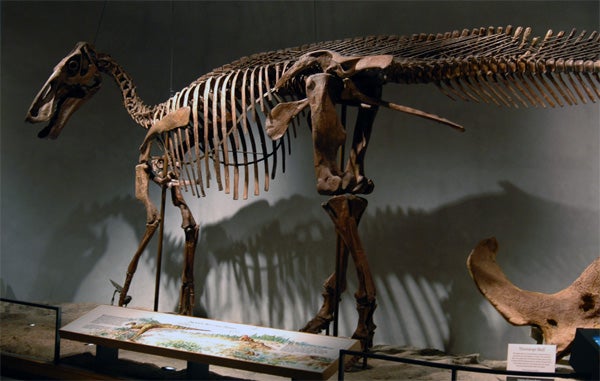
This Edmontosaurus at the Denver Museum of Nature and Science has a damaged tail, said to have been damaged by a tyrannosaur. But are there other hypotheses we should consider as alternatives? Photo by Firsfron, CC BY-SA 3.0.
Tooth wear and what we might learn about dinosaur diet and behaviour from phytoliths are covered, and a whole chapter is devoted to gastroliths. It’s well known in the dinosaur research community that the supposed ubiquity of gastroliths as important objects in the biology of sauropods has recently received substantial revision (Wings & Sander 2007). Martin covers all of this, but there’s so much more he covers too: Mesozoic theropod gastroliths, lasers and moa gastroliths, plesiosaur gastroliths (of course plesiosaurs aren’t dinosaurs, but what we know about their gastroliths is relevant to how we study those of dinosaurs), and those rounded stones discovered far away from dinosaur skeletons and yet suggested to be gastroliths anyway!
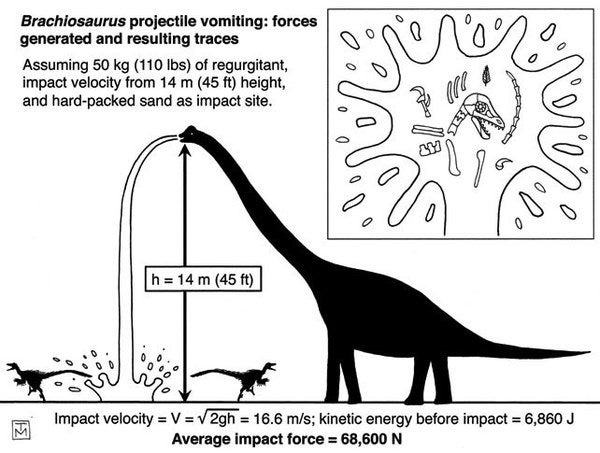
Projectile vomiting in a sauropod, as recontructed by Martin (2014).
Especially innovative is his chapter on droppings, urine, and vomit. This is where that famous (or should that be infamous?) diagram of a vomiting sauropod comes from (reproduced here). And by now I’m sure you’ve heard a lot about dinosaur urine and the sorts of bathtub-sized scour marks a giant pissing dinosaur might leave in sediment, a subject with links to the Angry Birds movie, apparently. And, yes, even desert-dwelling reptiles (including birds) can and do produce copious amounts of liquid urine.
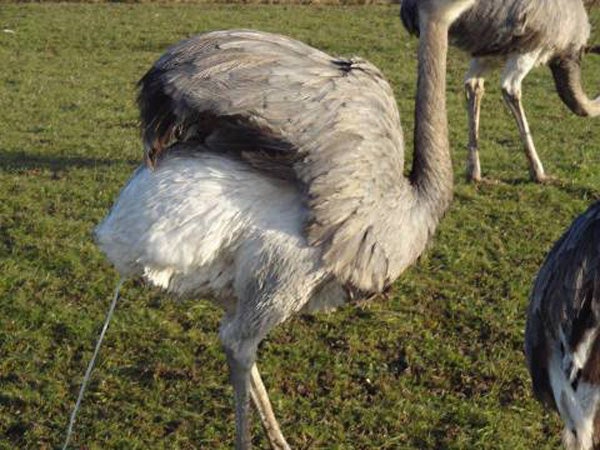
Birds can and do urinate: here's a rhea doing just that. Photo by Markus Bühler, taken from the famous SVPOW article Yes, folks, birds and crocs can pee.
The concept of burrow-dwelling non-bird dinosaurs might still be unfamiliar to non-specialists, but not only have we suspected that Mesozoic dinosaurs of several sorts might have excavated and utilised burrows (this has been suggested for small ceratopsians, for bipedal ornithischians of several sorts, for alvarezsaurids and – most bizarrely – for therizinosaurs), this hypothesis was beautifully confirmed in 2007 when David Varricchio and colleagues described specimens of the new small ornithischian Oryctodromeus preserved within the end chamber of a large, coiled burrow (Varricchio et al. 2007). To his credit, Martin comments on all of this: I was pleased to see mention of Bakker’s ideas about burrow-dwelling in the ornithischians Othnielia and Drinker, something that seems widely ignored by the community in general (in part because Bakker has never, to my knowledge, published an adequate report on this discovery). Note that I’m calling Oryctodromeus an ‘ornithischian’, not an ornithopod, in view of phylogenetic work which indicates that it and its kin (the orodromines) belong outside of Ornithopoda, and in fact are outside the ornithopod-marginocephalian clade Cerapoda (Boyd 2015).
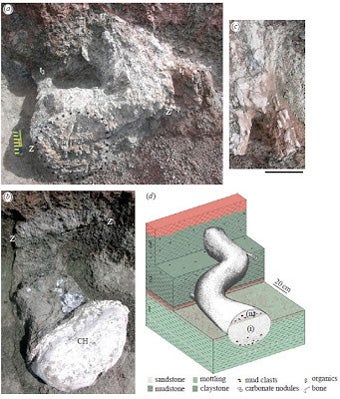
Oryctodromeus burrow, from Varricchio et al. (2007). Ornithischian dinosaurs in frikkin' burrows.
Anyway, Martin was extensively involved in the Oryctodromeus story, and Dinosaurs Without Bones includes a useful and fascinating chronicling of what happened. As is often the case with amazing discoveries, they didn’t realise exactly what they had right at the start. There’s also some discussion of how the technical paper fared during the publication process. It was only rejected twice. Martin implies that this is surprising, but readers should know that it might be considered normal, perhaps average, for a high-hitting paper aimed at the glamour mags.
A few specific discussions of dinosaur behaviour, biology and life appearance covered in Dinosaurs Without Bones will be of special interest to Tet Zoo readers. In fact, I’m pleased to say that Martin had cause to mention this very blog. It’s wholly conceivable that a dinosaur which rested or rolled around on the ground might have left traces of such activity; traces that might be incorporated into the fossil record. And one reason that a dinosaur might lie on the ground comes from a desire or need to sunbathe – it really is possible, given the ubiquity of sunbathing behaviour in birds, that we might one day find a fossilised impression created by a sunbathing non-bird dinosaur. My review of sunbathing habits in birds gets a mention here.
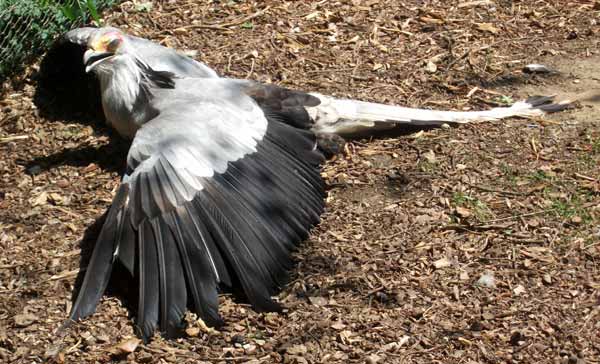
Sunbathing Secretary bird Sagittarius serpentarius. Non-bird dinosaurs of some sorts, at least, will have indulged in sunbathing too. Photo by Darren Naish.
Martin is also very much aware of the All Yesterdays movement and makes mention both of this book (Conway et al. 2013) and its follow-up (All Your Yesterdays), even being inspired to come up with a selection of unusual or obscure bits of weird palaeontological things-we-might-find himself…. like previously unexpected nest forms, and dinosaur sex traces. Yes: dinosaur sex traces (Martin 2014).
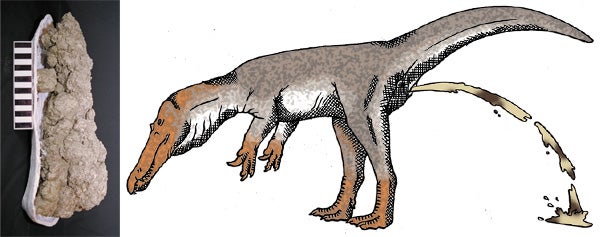
We know that Mesozoic dinosaurs produced droppings, and we have quite a few of them in the fossil record. Among the most famous is the giant tyrannosaurid coprolite from Saskatchewan shown at left. And we can have fun – All Yesterdays style – imagining Mesozoic dinosaurs defecating (as shown at right; image by Tim Morris).
A real strength of this book is the way Martin describes prediction in science, and hypothesis formulation and testing. A charge directed several times at the ichnological literature is that authors have elected to favour exciting, simple stories that don’t take account of all possibilities. Is that bite mark really a bite mark? Do those tracks really evidence that that dinosaur was swimming, or jumping, or grabbing hold of another one in combat? Martin is well aware of this and describes more than once how there might be alternative explanations for the things we observe, and – indeed – how experts have disagreed quite vehemently about specific cases (the classic example being the Lark Quarry tracks from Queensland). I really appreciate his taking the time to explain how competing lines of evidence can lead to competing explanations, and how all hypotheses are not always, necessarily, based on all evidence. We change our interpretations as more evidence comes in, and no scientific conclusion is ever ‘final’.
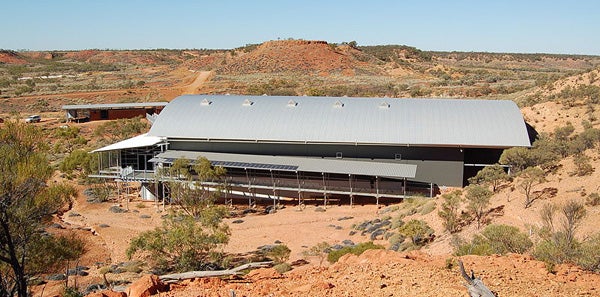
Lark Quarry will be familiar to you if you know the dinosaur literature, but the conservation building there might not be so familiar: here it is. Photo in public domain.
And, on that mention of finality, the possibly depressing point to make about conclusions as goes palaeoichnological hypotheses is that there will always be occasions where, no matter how good the evidence, we will simply never really know what happened, at least not without time travel.
Dinosaurs Without Bones is a substantial book: 460 pages, 11 chapters, and tons of content. It’s long. In fact, my one complaint is that I found some sections rather too long; there’s too much intro especially. The disclaimer here is that I’ve probably read more dinosaur books than the average reader and that lengthy expositions (on dinosaurs in general, and on the generalities concerning tracks and locomotion, for example) might be needed for more naïve readers.
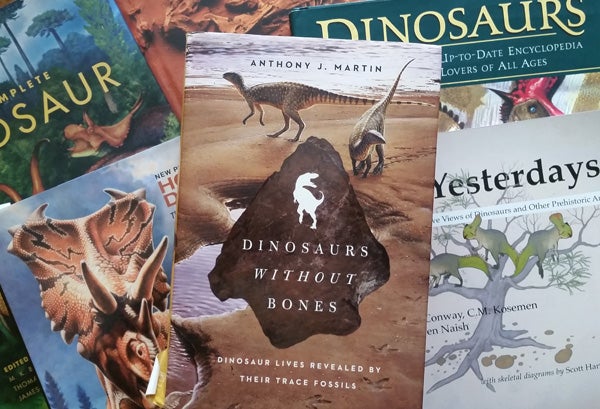
There are quite a few fun dinosaur books, and Dinosaurs Without Bones is among them.
I’ve said about these parts before that there are a lot of books about dinosaurs out there. As true as that is, one of the problems is that a lot of them really aren’t very good. Dinosaurs Without Bones joins a select few at the front of the pack, and the fact that it’s a remarkable mix of ‘popular read’ and ‘fully referenced tome with abundant science’ makes it quite unusual. I would mention it in the same breath as Brian Switek’s My Beloved Brontosaurus* and Tom Holtz and Luis Rey’s Dinosaurs: The Most Complete, Up-to-Date Encyclopedia for Dinosaur Lovers of All Ages. What I hope will be another good, strong popular dinosaur book is being published later this year, specifically in October.
* My review of which has mysteriously disappeared from the internet.
For previous Tet Zoo articles relevant to various of the topics covered here, see...
The hands of sauropods: horseshoes, spiky columns, stumps and banana shapes
The war on parasites: the pigeon’s eye view, the oviraptorosaur’s eye view
Did dinosaurs and pterosaurs practise mutual sexual selection?
Artistic Depictions of Dinosaurs Have Undergone Two Revolutions
Refs - -
Boyd, C. A. 2015. The systematic relationships and biogeographic history of ornithischian dinosaurs. PeerJ 3, e1523 doi:10.7717/peerj.1523
Martin, A. J. 2014. Dinosaurs Without Bones. Pegasus Books, New York.